《博弈论》导论
- 格式:ppt
- 大小:923.00 KB
- 文档页数:72
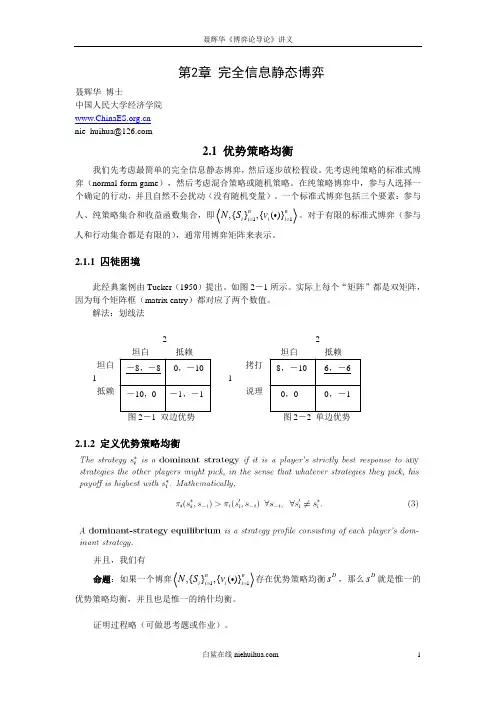
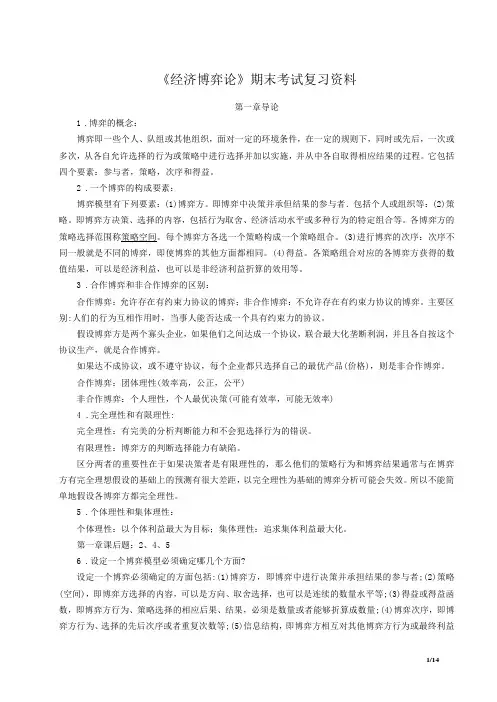
《经济博弈论》期末考试复习资料第一章导论1.博弈的概念:博弈即一些个人、队组或其他组织,面对一定的环境条件,在一定的规则下,同时或先后,一次或多次,从各自允许选择的行为或策略中进行选择并加以实施,并从中各自取得相应结果的过程。
它包括四个要素:参与者,策略,次序和得益。
2.一个博弈的构成要素:博弈模型有下列要素:(1)博弈方。
即博弈中决策并承但结果的参与者.包括个人或组织等:(2)策略。
即博弈方决策、选择的内容,包括行为取舍、经济活动水平或多种行为的特定组合等。
各博弈方的策略选择范围称策略空间。
每个博弈方各选一个策略构成一个策略组合。
(3)进行博弈的次序:次序不同一般就是不同的博弈,即使博弈的其他方面都相同。
(4)得益。
各策略组合对应的各博弈方获得的数值结果,可以是经济利益,也可以是非经济利益折算的效用等。
3.合作博弈和非合作博弈的区别:合作博弈:允许存在有约束力协议的博弈;非合作博弈:不允许存在有约束力协议的博弈。
主要区别:人们的行为互相作用时,当事人能否达成一个具有约束力的协议。
假设博弈方是两个寡头企业,如果他们之间达成一个协议,联合最大化垄断利润,并且各自按这个协议生产,就是合作博弈。
如果达不成协议,或不遵守协议,每个企业都只选择自己的最优产品(价格),则是非合作博弈。
合作博弈:团体理性(效率高,公正,公平)非合作博弈:个人理性,个人最优决策(可能有效率,可能无效率)4.完全理性和有限理性:完全理性:有完美的分析判断能力和不会犯选择行为的错误。
有限理性:博弈方的判断选择能力有缺陷。
区分两者的重要性在于如果决策者是有限理性的,那么他们的策略行为和博弈结果通常与在博弈方有完全理想假设的基础上的预测有很大差距,以完全理性为基础的博弈分析可能会失效。
所以不能简单地假设各博弈方都完全理性。
5.个体理性和集体理性:个体理性:以个体利益最大为目标;集体理性:追求集体利益最大化。
第一章课后题:2、4、56.设定一个博弈模型必须确定哪几个方面?设定一个博弈必须确定的方面包括:(1)博弈方,即博弈中进行决策并承担结果的参与者;(2)策略(空间),即博弈方选择的内容,可以是方向、取舍选择,也可以是连续的数量水平等;(3)得益或得益函数,即博弈方行为、策略选择的相应后果、结果,必须是数量或者能够折算成数量;(4)博弈次序,即博弈方行为、选择的先后次序或者重复次数等;(5)信息结构,即博弈方相互对其他博弈方行为或最终利益的了解程度;(6)行为逻辑和理性程度,即博弈方是依据个体理性还是集体理性行为,以及理性的程度等。
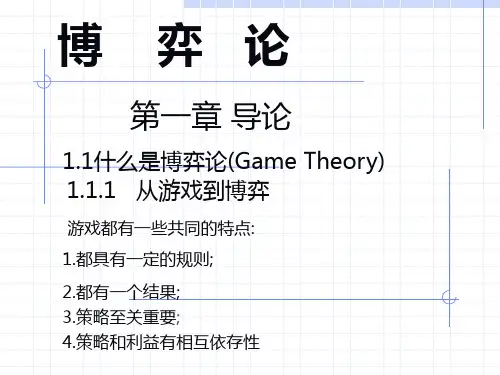





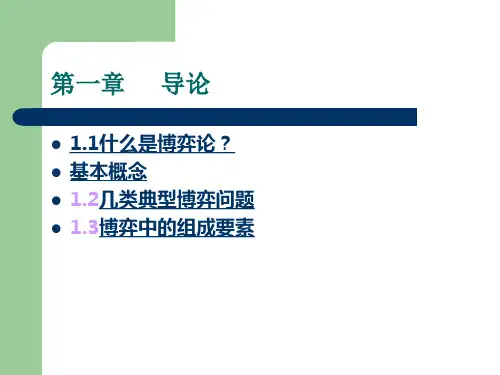

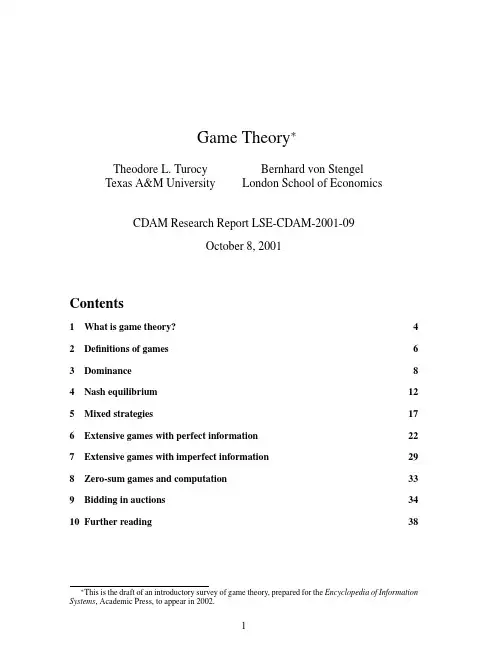
Game Theory∗Theodore L.Turocy Texas A&M UniversityBernhard von Stengel London School of EconomicsCDAM Research Report LSE-CDAM-2001-09October8,2001Contents1What is game theory?4 2Definitions of games6 3Dominance8 4Nash equilibrium12 5Mixed strategies17 6Extensive games with perfect information22 7Extensive games with imperfect information29 8Zero-sum games and computation33 9Bidding in auctions34 10Further reading38∗This is the draft of an introductory survey of game theory,prepared for the Encyclopedia of Information Systems,Academic Press,to appear in2002.GlossaryBackward inductionBackward induction is a technique to solve a game of perfect information.Itfirst consid-ers the moves that are the last in the game,and determines the best move for the player in each case.Then,taking these as given future actions,it proceeds backwards in time, again determining the best move for the respective player,until the beginning of the game is reached.Common knowledgeA fact is common knowledge if all players know it,and know that they all know it,and so on.The structure of the game is often assumed to be common knowledge among the players.Dominating strategyA strategy dominates another strategy of a player if it always gives a better payoff to that player,regardless of what the other players are doing.It weakly dominates the other strategy if it is always at least as good.Extensive gameAn extensive game(or extensive form game)describes with a tree how a game is played. It depicts the order in which players make moves,and the information each player has at each decision point.GameA game is a formal description of a strategic situation.Game theoryGame theory is the formal study of decision-making where several players must make choices that potentially affect the interests of the other players.Mixed strategyA mixed strategy is an active randomization,with given probabilities,that determines the player’s decision.As a special case,a mixed strategy can be the deterministic choice of one of the given pure strategies.Nash equilibriumA Nash equilibrium,also called strategic equilibrium,is a list of strategies,one for each player,which has the property that no player can unilaterally change his strategy and get a better payoff.PayoffA payoff is a number,also called utility,that reflects the desirability of an outcome to a player,for whatever reason.When the outcome is random,payoffs are usually weighted with their probabilities.The expected payoff incorporates the player’s attitude towards risk.Perfect informationA game has perfect information when at any point in time only one player makes a move, and knows all the actions that have been made until then.PlayerA player is an agent who makes decisions in a game.RationalityA player is said to be rational if he seeks to play in a manner which maximizes his own payoff.It is often assumed that the rationality of all players is common knowledge.Strategic formA game in strategic form,also called normal form,is a compact representation of a game in which players simultaneously choose their strategies.The resulting payoffs are pre-sented in a table with a cell for each strategy combination.StrategyIn a game in strategic form,a strategy is one of the given possible actions of a player.In an extensive game,a strategy is a complete plan of choices,one for each decision point of the player.Zero-sum gameA game is said to be zero-sum if for any outcome,the sum of the payoffs to all players is zero.In a two-player zero-sum game,one player’s gain is the other player’s loss,so their interests are diametrically opposed.1What is game theory?Game theory is the formal study of conflict and cooperation.Game theoretic concepts apply whenever the actions of several agents are interdependent.These agents may be individuals,groups,firms,or any combination of these.The concepts of game theory provide a language to formulate,structure,analyze,and understand strategic scenarios.History and impact of game theoryThe earliest example of a formal game-theoretic analysis is the study of a duopoly by Antoine Cournot in1838.The mathematician Emile Borel suggested a formal theory of games in1921,which was furthered by the mathematician John von Neumann in1928 in a“theory of parlor games.”Game theory was established as afield in its own right after the1944publication of the monumental volume Theory of Games and Economic Behavior by von Neumann and the economist Oskar Morgenstern.This book provided much of the basic terminology and problem setup that is still in use today.In1950,John Nash demonstrated thatfinite games have always have an equilibrium point,at which all players choose actions which are best for them given their opponents’choices.This central concept of noncooperative game theory has been a focal point of analysis since then.In the1950s and1960s,game theory was broadened theoretically and applied to problems of war and politics.Since the1970s,it has driven a revolutionin economic theory.Additionally,it has found applications in sociology and psychology, and established links with evolution and biology.Game theory received special attention in1994with the awarding of the Nobel prize in economics to Nash,John Harsanyi,and Reinhard Selten.At the end of the1990s,a high-profile application of game theory has been the design of auctions.Prominent game theorists have been involved in the design of auctions for al-locating rights to the use of bands of the electromagnetic spectrum to the mobile telecom-munications industry.Most of these auctions were designed with the goal of allocating these resources more efficiently than traditional governmental practices,and additionally raised billions of dollars in the United States and Europe.Game theory and information systemsThe internal consistency and mathematical foundations of game theory make it a prime tool for modeling and designing automated decision-making processes in interactive en-vironments.For example,one might like to have efficient bidding rules for an auction website,or tamper-proof automated negotiations for purchasing communication band-width.Research in these applications of game theory is the topic of recent conference and journal papers(see,for example,Binmore and Vulkan,“Applying game theory to auto-mated negotiation,”Netnomics V ol.1,1999,pages1–9)but is still in a nascent stage.The automation of strategic choices enhances the need for these choices to be made efficiently, and to be robust against abuse.Game theory addresses these requirements.As a mathematical tool for the decision-maker the strength of game theory is the methodology it provides for structuring and analyzing problems of strategic choice.The process of formally modeling a situation as a game requires the decision-maker to enu-merate explicitly the players and their strategic options,and to consider their preferences and reactions.The discipline involved in constructing such a model already has the poten-tial of providing the decision-maker with a clearer and broader view of the situation.This is a“prescriptive”application of game theory,with the goal of improved strategic deci-sion making.With this perspective in mind,this article explains basic principles of game theory,as an introduction to an interested reader without a background in economics.2Definitions of gamesThe object of study in game theory is the game,which is a formal model of an interactive situation.It typically involves several players;a game with only one player is usually called a decision problem.The formal definition lays out the players,their preferences, their information,the strategic actions available to them,and how these influence the outcome.Games can be described formally at various levels of detail.A coalitional(or cooper-ative)game is a high-level description,specifying only what payoffs each potential group, or coalition,can obtain by the cooperation of its members.What is not made explicit is the process by which the coalition forms.As an example,the players may be several parties in parliament.Each party has a different strength,based upon the number of seats occupied by party members.The game describes which coalitions of parties can form a majority,but does not delineate,for example,the negotiation process through which an agreement to vote en bloc is achieved.Cooperative game theory investigates such coalitional games with respect to the rel-ative amounts of power held by various players,or how a successful coalition should divide its proceeds.This is most naturally applied to situations arising in political science or international relations,where concepts like power are most important.For example, Nash proposed a solution for the division of gains from agreement in a bargaining prob-lem which depends solely on the relative strengths of the two parties’bargaining position. The amount of power a side has is determined by the usually inefficient outcome that results when negotiations break down.Nash’s modelfits within the cooperative frame-work in that it does not delineate a specific timeline of offers and counteroffers,but rather focuses solely on the outcome of the bargaining process.In contrast,noncooperative game theory is concerned with the analysis of strategic choices.The paradigm of noncooperative game theory is that the details of the ordering and timing of players’choices are crucial to determining the outcome of a game.In contrast to Nash’s cooperative model,a noncooperative model of bargaining would posit a specific process in which it is prespecified who gets to make an offer at a given time.The term“noncooperative”means this branch of game theory explicitly models the process ofplayers making choices out of their own interest.Cooperation can,and often does,arise in noncooperative models of games,when playersfind it in their own best interests.Branches of game theory also differ in their assumptions.A central assumption in many variants of game theory is that the players are rational.A rational player is one who always chooses an action which gives the outcome he most prefers,given what he expects his opponents to do.The goal of game-theoretic analysis in these branches,then, is to predict how the game will be played by rational players,or,relatedly,to give ad-vice on how best to play the game against opponents who are rational.This rationality assumption can be relaxed,and the resulting models have been more recently applied to the analysis of observed behavior(see Kagel and Roth,eds.,Handbook of Experimental Economics,Princeton Univ.Press,1997).This kind of game theory can be viewed as more“descriptive”than the prescriptive approach taken here.This article focuses principally on noncooperative game theory with rational play-ers.In addition to providing an important baseline case in economic theory,this case is designed so that it gives good advice to the decision-maker,even when–or perhaps especially when–one’s opponents also employ it.Strategic and extensive form gamesThe strategic form(also called normal form)is the basic type of game studied in non-cooperative game theory.A game in strategic form lists each player’s strategies,and the outcomes that result from each possible combination of choices.An outcome is repre-sented by a separate payoff for each player,which is a number(also called utility)that measures how much the player likes the outcome.The extensive form,also called a game tree,is more detailed than the strategic form of a game.It is a complete description of how the game is played over time.This includes the order in which players take actions,the information that players have at the time they must take those actions,and the times at which any uncertainty in the situation is resolved.A game in extensive form may be analyzed directly,or can be converted into an equivalent strategic form.Examples in the following sections will illustrate in detail the interpretation and anal-ysis of games in strategic and extensive form.3DominanceSince all players are assumed to be rational,they make choices which result in the out-come they prefer most,given what their opponents do.In the extreme case,a player may have two strategies A and B so that,given any combination of strategies of the other players,the outcome resulting from A is better than the outcome resulting from B .Then strategy A is said to dominate strategy B .A rational player will never choose to play a dominated strategy.In some games,examination of which strategies are dominated re-sults in the conclusion that rational players could only ever choose one of their strategies.The following examples illustrate this idea.Example:Prisoner’s DilemmaThe Prisoner’s Dilemma is a game in strategic form between two players.Each player has two strategies,called “cooperate”and “defect,”which are labeled C and D for player I and c and d for player II,respectively.(For simpler identification,upper case letters are used for strategies of player I and lower case letters for player II.)d d d 22300311I IIC D cd Figure 1.The Prisoner’s Dilemma game.Figure 1shows the resulting payoffs in this game.Player I chooses a row,either C or D ,and simultaneously player II chooses one of the columns c or d .The strategy combination (C,c )has payoff 2for each player,and the combination (D,d )gives each player payoff 1.The combination (C,d )results in payoff 0for player I and 3for player II,and when (D,c )is played,player I gets 3and player II gets 0.Any two-player game in strategic form can be described by a table like the one in Figure 1,with rows representing the strategies of player I and columns those of player II.(A player may have more than two strategies.)Each strategy combination defines a payoff pair,like (3,0)for (D,c ),which is given in the respective table entry.Each cell of the table shows the payoff to player I at the (lower)left,and the payoff to player II at the (right)top.These staggered payoffs,due to Thomas Schelling,also make transparent when,as here,the game is symmetric between the two players.Symmetry means that the game stays the same when the players are exchanged,corresponding to a reflection along the diagonal shown as a dotted line in Figure 2.Note that in the strategic form,there is no order between player I and II since they act simultaneously (that is,without knowing the other’s action),which makes the symmetry possible...................................................d d d 22300311I IIC Dc d ↓↓→→Figure 2.The game of Figure 1with annotations,implied by the payoff structure.Thedotted line shows the symmetry of the game.The arrows at the left and right point to the preferred strategy of player I when player II plays the left or right column,respectively.Similarly,the arrows at the top and bottom point to the preferred strategy of player II when player I plays top or bottom.In the Prisoner’s Dilemma game,“defect”is a strategy that dominates “cooperate.”Strategy D of player I dominates C since if player II chooses c ,then player I’s payoff is 3when choosing D and 2when choosing C ;if player II chooses d ,then player I receives 1for D as opposed to 0for C .These preferences of player I are indicated by the downward-pointing arrows in Figure 2.Hence,D is indeed always better and dominates C .In the same way,strategy d dominates c for player II.No rational player will choose a dominated strategy since the player will always be better off when changing to the strategy that dominates it.The unique outcome in this game,as recommended to utility-maximizing players,is therefore(D,d)with payoffs (1,1).Somewhat paradoxically,this is less than the payoff(2,2)that would be achieved when the players chose(C,c).The story behind the name“Prisoner’s Dilemma”is that of two prisoners held suspect of a serious crime.There is no judicial evidence for this crime except if one of the prison-ers testifies against the other.If one of them testifies,he will be rewarded with immunity from prosecution(payoff3),whereas the other will serve a long prison sentence(pay-off0).If both testify,their punishment will be less severe(payoff1for each).However,if they both“cooperate”with each other by not testifying at all,they will only be imprisoned briefly,for example for illegal weapons possession(payoff2for each).The“defection”from that mutually beneficial outcome is to testify,which gives a higher payoff no matter what the other prisoner does,with a resulting lower payoff to both.This constitutes their “dilemma.”Prisoner’s Dilemma games arise in various contexts where individual“defections”at the expense of others lead to overall less desirable outcomes.Examples include arms races,litigation instead of settlement,environmental pollution,or cut-price marketing, where the resulting outcome is detrimental for the players.Its game-theoretic justification on individual grounds is sometimes taken as a case for treaties and laws,which enforce cooperation.Game theorists have tried to tackle the obvious“inefficiency”of the outcome of the Prisoner’s Dilemma game.For example,the game is fundamentally changed by playing it more than once.In such a repeated game,patterns of cooperation can be established as rational behavior when players’fear of punishment in the future outweighs their gain from defecting today.Example:Quality choiceThe next example of a game illustrates how the principle of elimination of dominated strategies may be applied iteratively.Suppose player I is an internet service provider and player II a potential customer.They consider entering into a contract of service provision for a period of time.The provider can,for himself,decide between two levels of qualityof service,High or Low .High-quality service is more costly to provide,and some of the cost is independent of whether the contract is signed or not.The level of service cannot be put verifiably into the contract.High-quality service is more valuable than low-quality service to the customer,in fact so much so that the customer would prefer not to buy the service if she knew that the quality was low.Her choices are to buy or not to buy the service.d d d 22300111I IIHigh Low buydon’t buy ↓↓→←Figure 3.High-low quality game between a service provider (player I)and a customer(player II).Figure 3gives possible payoffs that describe this situation.The customer prefers to buy if player I provides high-quality service,and not to buy otherwise.Regardless of whether the customer chooses to buy or not,the provider always prefers to provide the low-quality service.Therefore,the strategy Low dominates the strategy High for player I.Now,since player II believes player I is rational,she realizes that player I always prefers Low ,and so she anticipates low quality service as the provider’s choice.Then she prefers not to buy (giving her a payoff of 1)to buy (payoff 0).Therefore,the rationality of both players leads to the conclusion that the provider will implement low-quality service and,as a result,the contract will not be signed.This game is very similar to the Prisoner’s Dilemma in Figure 1.In fact,it differs only by a single payoff,namely payoff 1(rather than 3)to player II in the top right cell in the table.This reverses the top arrow from right to left,and makes the preference of player II dependent on the action of player I.(The game is also no longer symmetric.)Player II does not have a dominating strategy.However,player I still does,so that theresulting outcome,seen from the“flow of arrows”in Figure3,is still unique.Another way of obtaining this outcome is the successive elimination of dominated strategies:First, High is eliminated,and in the resulting smaller game where player I has only the single strategy Low available,player II’s strategy buy is dominated and also removed.As in the Prisoner’s Dilemma,the individually rational outcome is worse for both players than another outcome,namely the strategy combination(High,buy)where high-quality service is provided and the customer signs the contract.However,that outcome is not credible,since the provider would be tempted to renege and provide only the low-quality service.4Nash equilibriumIn the previous examples,consideration of dominating strategies alone yielded precise advice to the players on how to play the game.In many games,however,there are no dominated strategies,and so these considerations are not enough to rule out any outcomes or to provide more specific advice on how to play the game.The central concept of Nash equilibrium is much more general.A Nash equilibrium recommends a strategy to each player that the player cannot improve upon unilaterally, that is,given that the other players follow the recommendation.Since the other players are also rational,it is reasonable for each player to expect his opponents to follow the recommendation as well.Example:Quality choice revisitedA game-theoretic analysis can highlight aspects of an interactive situation that could be changed to get a better outcome.In the quality game in Figure3,for example,increasing the customer’s utility of high-quality service has no effect unless the provider has an incentive to provide that service.So suppose that the game is changed by introducing an opt-out clause into the service contract.That is,the customer can discontinue subscribing to the service if shefinds it of low quality.The resulting game is shown in Figure4.Here,low-quality service provision,even when the customer decides to buy,has the same low payoff1to the provider as when thed d d 22100111I IIHigh Low buydon’t buy ↑↓→←Figure 4.High-low quality game with opt-out clause for the customer.The left arrowshows that player I prefers High when player II chooses buy .customer does not sign the contract in the first place,since the customer will opt out later.However,the customer still prefers not to buy when the service is Low in order to spare herself the hassle of entering the contract.The changed payoff to player I means that the left arrow in Figure 4points upwards.Note that,compared to Figure 3,only the provider’s payoffs are changed.In a sense,the opt-out clause in the contract has the purpose of convincing the customer that the high-quality service provision is in the provider’s own interest.This game has no dominated strategy for either player.The arrows point in different directions.The game has two Nash equilibria in which each player chooses his strategy deterministically.One of them is,as before,the strategy combination (Low,don’t buy ).This is an equilibrium since Low is the best response (payoff-maximizing strategy)to don’t buy and vice versa.The second Nash equilibrium is the strategy combination (High,buy ).It is an equilib-rium since player I prefers to provide high-quality service when the customer buys,and conversely,player II prefers to buy when the quality is high.This equilibrium has a higher payoff to both players than the former one,and is a more desirable solution.Both Nash equilibria are legitimate recommendations to the two players of how to play the game.Once the players have settled on strategies that form a Nash equilibrium,neither player has incentive to deviate,so that they will rationally stay with their strategies.This makes the Nash equilibrium a consistent solution concept for games.In contrast,astrategy combination that is not a Nash equilibrium is not a credible solution.Such a strategy combination would not be a reliable recommendation on how to play the game, since at least one player would rather ignore the advice and instead play another strategy to make himself better off.As this example shows,a Nash equilibrium may be not unique.However,the pre-viously discussed solutions to the Prisoner’s Dilemma and to the quality choice game in Figure3are unique Nash equilibria.A dominated strategy can never be part of an equilib-rium since a player intending to play a dominated strategy could switch to the dominating strategy and be better off.Thus,if elimination of dominated strategies leads to a unique strategy combination,then this is a Nash rger games may also have unique equilibria that do not result from dominance considerations.Equilibrium selectionIf a game has more than one Nash equilibrium,a theory of strategic interaction should guide players towards the“most reasonable”equilibrium upon which they should focus. Indeed,a large number of papers in game theory have been concerned with“equilibrium refinements”that attempt to derive conditions that make one equilibrium more plausible or convincing than another.For example,it could be argued that an equilibrium that is better for both players,like(High,buy)in Figure4,should be the one that is played.However,the abstract theoretical considerations for equilibrium selection are often more sophisticated than the simple game-theoretical models they are applied to.It may be more illuminating to observe that a game has more than one equilibrium,and that this is a reason that players are sometimes stuck at an inferior outcome.One and the same game may also have a different interpretation where a previously undesirable equilibrium becomes rather plausible.As an example,consider an alternative scenario for the game in Figure4.Unlike the previous situation,it will have a symmetric description of the players,in line with the symmetry of the payoff structure.Twofirms want to invest in communication infrastructure.They intend to communi-cate frequently with each other using that infrastructure,but they decide independently on what to buy.Eachfirm can decide between High or Low bandwidth equipment(thistime,the same strategy names will be used for both players).For player II,High and Low replace buy and don’t buy in Figure 4.The rest of the game stays as it is.The (unchanged)payoffs have the following interpretation for player I (which applies in the same way to player II by symmetry):A Low bandwidth connection works equally well (payoff 1)regardless of whether the other side has high or low bandwidth.How-ever,switching from Low to High is preferable only if the other side has high bandwidth (payoff 2),otherwise it incurs unnecessary cost (payoff 0).As in the quality game,the equilibrium (Low,Low )(the bottom right cell)is inferior to the other equilibrium,although in this interpretation it does not look quite as bad.Moreover,the strategy Low has obviously the better worst-case payoff,as considered for all possible strategies of the other player,no matter if these strategies are rational choices or not.The strategy Low is therefore also called a max-min strategy since it maximizes the minimum payoff the player can get in each case.In a sense,investing only in low-bandwidth equipment is a safe choice.Moreover,this strategy is part of an equilibrium,and entirely justified if the player expects the other player to do the same.Evolutionary gamesThe bandwidth choice game can be given a different interpretation where it applies to a large population of identical players.Equilibrium can then be viewed as the outcome of a dynamic process rather than of conscious rational analysis.d d d 55100111I IIHigh LowHigh Low ↑↓→←Figure 5.The bandwidth choice game.Figure5shows the bandwidth choice game where each player has the two strategies High and Low.The positive payoff of5for each player for the strategy combination (High,High)makes this an even more preferable equilibrium than in the case discussed above.In the evolutionary interpretation,there is a large population of individuals,each of which can adopt one of the strategies.The game describes the payoffs that result when two of these individuals meet.The dynamics of this game are based on assuming that each strategy is played by a certain fraction of individuals.Then,given this distribution of strategies,individuals with better average payoff will be more successful than others, so that their proportion in the population increases over time.This,in turn,may affect which strategies are better than others.In many cases,in particular in symmetric games with only two possible strategies,the dynamic process will move to an equilibrium.In the example of Figure5,a certain fraction of users connected to a network will already have High or Low bandwidth equipment.For example,suppose that one quarter of the users has chosen High and three quarters have chosen Low.It is useful to assign these as percentages to the columns,which represent the strategies of player II.A new user,as player I,is then to decide between High and Low,where his payoff depends on the given fractions.Here it will be1/4×5+3/4×0=1.25when player I chooses High,and 1/4×1+3/4×1=1when player I chooses Low.Given the average payoff that player I can expect when interacting with other users,player I will be better off by choosing High, and so decides on that strategy.Then,player I joins the population as a High user.The proportion of individuals of type High therefore increases,and over time the advantage of that strategy will become even more pronounced.In addition,users replacing their equipment will make the same calculation,and therefore also switch from Low to High. Eventually,everyone plays High as the only surviving strategy,which corresponds to the equilibrium in the top left cell in Figure5.The long-term outcome where only high-bandwidth equipment is selected depends on there being an initial fraction of high-bandwidth users that is large enough.For example,if only ten percent have chosen High,then the expected payoff for High is0.1×5+0.9×0= 0.5which is less than the expected payoff1for Low(which is always1,irrespective of the distribution of users in the population).Then,by the same logic as before,the fraction of Low users increases,moving to the bottom right cell of the game as the equilibrium.It。
博弈论导论《博弈论》主讲:李少斌 Tel:85221808 Email:tlishb@第0章《博弈论》导论《博弈论》研究什么, Game Theory游戏理论,对策论,博弈论下棋与博弈: 博弈论研究的问题决策及其均衡问题理性经济人(智能的) 行为互动假设:相互影响经济学研究假设基础经济学研究内容: 经济学研究的假设基础: 理性经济人新古典经济学的两个基本假定: 完全竞争市场不存在信息不对称问题博弈论的研究范式传统经济学研究范式:生产或消费的决策者在做出决策时,假设价格是固定不变的,以此使其效用最大化。
决策者是价格的接受者博弈论的突破:决策时考虑到主体的决策行为是互相影响的,即局中人决策时将考虑到其竞争对手的行为,并且预料到竞争对手对其行为的策略式反应;个人的最优选择是其他人选择的函数。
价格影响者:互动,相互影响一、生活中的博弈现象海滩占位问题 :二人对称矩阵博弈:二人矩阵博弈:智猪博弈公共产品供给问题:1、海滩占位问题两个卖矿泉水的小商贩为了争夺在海滩上日光浴的顾客,假若晒太阳的人们在1公理长的沙滩上均匀分布,试问:两个商贩将如何布局,海滩占位问题求解帕累托最优:纳什均衡:类似的例子电视台的娱乐节目竞争现象(节目克隆) 总统竞选的竞选纲领问题(尽量争取中间选民) 超市的布局问题不同航空公司飞往同一目的地的航班现象地方政府竞相设立开发区支付函数的矩阵博弈问题在现实中最常见的博弈问题通常是二人博弈问题,每一博弈方的行动选择通常只有两种,在这样的博弈问题中双方的得益函数通常可用一个矩阵来描述。
如图:参与人B 参与人A U L a, e R b, fDc, gd, h2、二人对称矩阵博弈考查二人对称博弈。
双方各有合作和不合作两种策略,其得益支付矩阵如下。
由其相对大小确定了不同类型的博弈问题。
这里,合作理解为投对方所好,或者说选择对方所希望的策略;不合作可理解为背叛。
参与人B 合作不合作合作参与人A 不合作 r, r t, s s,t p, p(1)囚徒困境博弈(t,r,p,s)两个小偷被控有罪,法官对其分别审判,每个小偷决定是坦白还是抵赖,其得益矩阵如下。
博弈论导论第一章导论提要:本章首先对博弈论的一些基本概念,包括什么是博弈和博弈论等作初步介绍。
然后在此基础上再给出一些经典的博弈例子,使学生对博弈论的内容和博弈模型有更直观的概念和印象。
最后,我们还要对博弈的分类和博弈理论的结构做一些讨论。
§1 什么是博弈论想一想:假如你正跟恋人用手机通电话,突然信号断了。
这时,你会立即拨电话过去,还是等你的恋人拨电话过来?很显然,你是否应该拨电话过去,取决于你的恋人是否会拨电话过来。
如果你们其中一方要拨,那么,另一方最好是等待;如果一方等待,另一方就最好是拨过去。
因为如果双方都拨,就会出现线路忙;如果双方都等待,那么时间就会在等待中流逝。
是等待还是拨过去,这,就是博弈!§1.1 从游戏到博弈“博弈论”译自英文“game theory”。
“game”的基本含义是游戏,因此,“game theory”直译应该是“游戏理论”。
说起游戏当然大家都非常熟悉,日常生活中的打牌下棋、赌博博彩,以及田径、球类等各种体育比赛,都是游戏,是不同种类、不同形式的游戏。
游戏的种类很多,我们很难将它们一一列举出来。
不过,如果我们认真观察、思考一下就能发现,很多游戏都有下列共同的本质特征:(1)都有一定的规则——规则是游戏的参与者(个人或队组)可以做什么、不可以做什么,应该按怎样的次序做,什么时候结束游戏和一旦参与者犯规将受到怎样的处罚等。
(2)都有一个结果——如一方赢一方输、平局或各参与方各有所得等,而且结果通常能用正或负的数值表示。
(3)策略至关重要——游戏者不同的策略选择常会带来不同的游戏结果。
(4)策略和利益有相互依存性——即每一个游戏参与者所得结果的好坏,不仅取决于自身的策略选择,也取决于其他参与者的策略选择。
有时一个差的策略选择也许会带来并不差的结果,原因是其他的参与者选择了更差的策略。
因此,在有策略依存性的游戏中,策略本身常常没有绝对的好坏之分,只有相对于他方策略的相对好坏。
博弈论导论课程编码:0RL05308课程名称(英文):Game Theory适应专业:市场营销课程性质:专业任选课学时:32学时,其中讲课:32学时先修课程::管理学原理、微观经济学、数学分析与概率论一、本课程的地位、作用与任务博弈论是一门决策管理学的科学,其目的是使学生学会应用博弈论的基本原理和方法分析经济、管理和社会生活等领域的博弈问题,帮助学生获得必要的决策科学基本知识,管理决策的基本方法和基本技能。
二、内容、学时及基本要求序号内容基本要求学时1第1章绪论1.1博弈论的研究对象1.2博弈论的主要分类1.3博弈论与决策理论掌握博弈论的基本概念;掌握博弈论的主要分类;了解博弈论与决策理论的关系。
62第2章完全信息静态博弈2.1纳什均衡2.2纳什均衡的存在性与多重性讨论2.3混合策略的纳什均衡及其存在性掌握纳什均衡以及混合策略的纳什均衡,了解其存在性和多重性。
83第3章完全信息动态博弈3.1完全且完美信息动态博弈3.2完全非完美信息动态博弈3.3重复博弈掌握完全且完美信息动态博弈和完全非完美信息动态博弈,了解重复博弈6序号内容基本要求学时4第4章非完全信息静态博弈4.1不完全信息静态博弈4.2贝叶斯博弈4.3贝叶斯纳什均衡掌握不完全信息静态博弈,掌握贝叶斯博弈及均衡65第5章非完全信息动态博弈5.1精练贝叶斯纳什均衡5.2信号博弈掌握精练贝叶斯纳什均衡、信号博弈6总计32三、说明本课程是一门理论性和实践性都很强的课程,为此教学过程中要高度理论联系实际,既要深入浅出、生动活泼、引起兴趣,又要保证理论内容的完整性、准确性和必要深度。
尽可能地结合多种教学方法和手段,如案例的分析、课堂的讨论等。
帮助学生理解和掌握博弈论的基本原理和方法。
考核方式:平时30%(作业+平时考核)+期末考试(闭卷/开卷/论文)70%。
四、使用教材及参考书教 材:谢识予著,经济博弈论(第三版),复旦大学出版社,2008参考书:张维迎著,博弈论与信息经济学,上海人民出版社,2004。